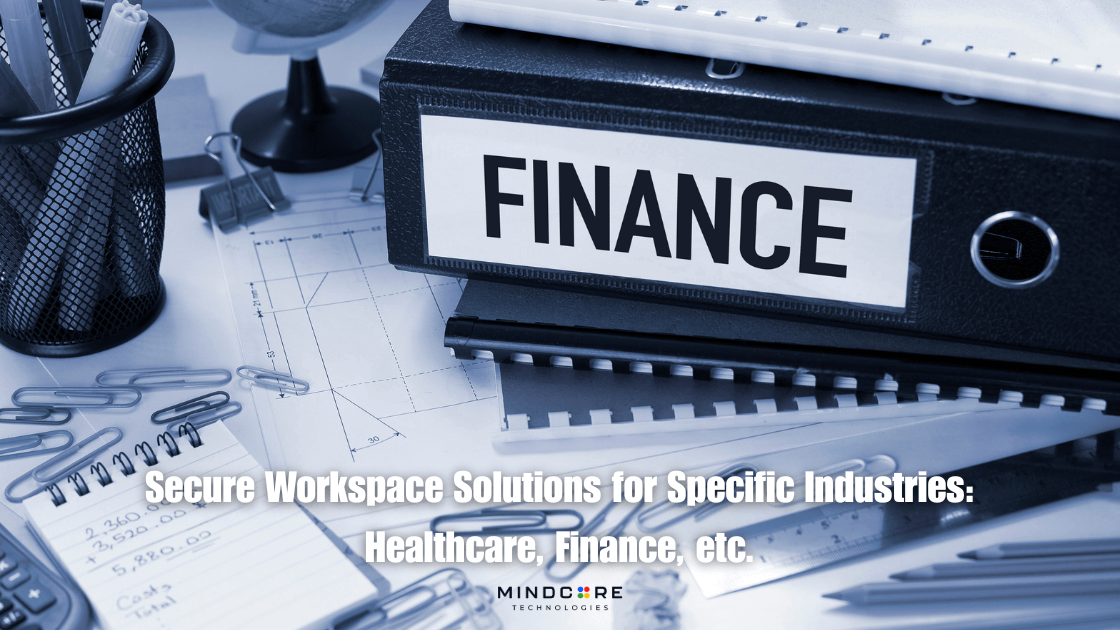Some industries don’t just want better security—they need it. Healthcare, finance, legal, and even retail teams handle sensitive data every day. And when workers are spread across cities, home offices, and different devices, it gets harder to stay in control.
That’s where secure workspace solutions step in. These platforms give every team member a safe, virtual space to access files, apps, and systems—without exposing the business to unnecessary risks. But what works for a law firm won’t always fit a hospital. Each industry has its own rules, pain points, and must-haves.
Let’s look at how secure workspace solutions are being used across different sectors, and why they’re becoming a must-have instead of a nice-to-have.
Healthcare: Keeping Patient Data Safe Without Slowing Teams
Healthcare information is not only important; it is also protected by law. Clinics, hospitals, and remote care providers must ensure HIPAA compliance while also maintaining patient privacy and avoiding downtime.
One mid-sized clinic in this situation had doctors working out of several locations with the need for patient record access. However, by the time the IT configuration was evaluated, there was no way of controlling what happened on those personal devices. Hence, a secure environment with endpoint isolation, session recording, and real-time monitoring was put in place. This provided the staff with everything they needed while protecting sensitive data.
What healthcare teams gain:
- HIPAA and ISO 27001 compliance support
- Secure access from any location
- Real-time monitoring and activity tracking
- Encrypted data storage and transmission
- Built-in audit logs and session tracking
This approach aligns with strict industry regulations like HIPAA and ISO 27001. And the tools like VDI, zero-trust access, and audit logs are often built right into the workspace. Many platforms are designed with compliance in mind, as we covered in our guide on regulatory compliance for secure workspaces.
Finance: Making Audits Easier and Data Safer
Financial companies face pressure from all sides. They need to protect account info, meet standards like SOC-2 and PCI-DSS, and stay ready for audits. Add in remote advisors and hybrid offices, and things get complicated fast.
A regional finance firm struggled to manage users across multiple platforms. Logins weren’t tracked. Endpoints weren’t updated. When they moved to a secure workspace platform, they got centralized access, automated session logging, and strict role-based permissions. This helped them pass their annual audit with zero issues.
Benefits for finance teams:
- Role-based access control
- SOC-2, ISO 27001, and PCI-DSS support
- Session logging and audit-ready reports
- Centralized IT management
Features like session recordings, policy enforcement, and detailed access logs make it easier to manage ISO 27001 compliance. These same capabilities support other regulated industries, making secure workspaces a smart long-term investment.
Legal Firms: Locking Down Confidential Conversations
Law firms thrive on confidentiality. Client data, legal files, and sensitive communication all need to stay protected—even when teams are working across different time zones.
For one boutique legal team, email attachments and file sharing became risky. They needed a way to collaborate without leaking data. A secure workspace platform gave them encrypted document access, zero-trust authentication, and a log of who accessed what and when.
How legal firms benefit:
- End-to-end encrypted document access
- Zero-trust access for remote legal teams
- Role-based permissions for document handling
- Full visibility and audit logs for compliance
- GDPR-ready monitoring tools
Tools like role-based access control and endpoint monitoring helped the firm stay GDPR-compliant and reduce the risk of insider threats. It’s one reason law firms now look to secure workspace platforms instead of traditional VPNs or cloud storage alone.
Retail & E-Commerce: Fast Setup, Smooth Operations
Retail and e-commerce companies move quickly. They manage customer service, inventory, and vendors across regions—and they do it all online. But with that speed comes risk.
A fast-growing e-commerce brand had teams across four countries. Staff used their own laptops. Vendors needed temporary access. And their VPN? It kept crashing.
When they switched to a secure workspace platform, they got instant cloud desktops, real-time visibility, and no more VPN drama. They also saved on overlapping software costs by consolidating their tools.
Retail advantages:
- Temporary access for vendors
- Centralized app and tool management
- Better visibility across global teams
- Reduced costs with all-in-one platform
Secure workspaces also help businesses reduce the cost of IT and improve ROI, especially when paired with usage-based pricing. This is something we explored further in our breakdown of budgeting and ROI for secure workspace solutions.
Creative Agencies: Fast Collaboration Without Data Leaks
Creative teams need freedom to work, but also need to protect client files. Many agencies work with freelancers or outside contributors, which makes file sharing risky.
One creative agency used a secure workspace to give each contractor access only to the tools and files they needed. With activity logs and time-limited sessions, the team could track everything without slowing down workflows.
Top benefits for creative teams:
- Scoped access per project or user
- Built-in monitoring for contractor work
- Fast setup for freelancers
- Safe file sharing without email attachments
One creative agency used a secure workspace to give each contractor access only to the tools and files they needed. With activity logs and time-limited sessions, the team could track everything without slowing down workflows.
Startups & SaaS Teams: Growing Securely
Startups are built for speed. But fast growth brings risks—like data leaks, unsecured devices, and inconsistent access control.
One SaaS company used a secure workspace to scale. As they hired engineers and salespeople in different countries, they rolled out pre-configured virtual desktops. Each team had access to only what they needed. And when a contractor left, their access disappeared instantly.
Why startups use secure workspaces:
- Fast deployment with prebuilt desktops
- Simple offboarding for short-term workers
- Compliance readiness from day one
- Secure collaboration across regions
With smart onboarding, session control, and multi-region access, the team grew without compromising security.
Across Industries: Shared Wins
Here’s a quick snapshot of how different industries are using secure workspaces to address their specific challenges:
| Industry | Common Challenge | Secure Workspace Solution | Outcome |
| Healthcare | Patient data access on personal devices | Endpoint isolation, session recording, VDI | Compliance with HIPAA, secure remote access |
| Finance | Audit-readiness, unmanaged endpoints | Role-based access, session logging | Passed audits, centralized IT control |
| Legal | Data sharing across time zones | Encrypted file access, access logs | Maintained GDPR compliance, reduced risk |
| Retail/E-Com | VPN crashes, vendor access | Cloud desktops, real-time visibility | Improved uptime, saved on software costs |
| Creative Agency | Freelancers handling sensitive files | Scoped access, activity tracking | No data leaks, faster onboarding |
| SaaS / Startup | Scattered global teams, fast scaling | Pre-configured desktops, instant provisioning | Rapid team growth without security tradeoffs |
Final Thoughts: One Platform, Many Possibilities
Now, secure workspace solutions are not just about remote access; they also ensure control, visibility, and confidence in protecting sensitive patient information, financial records, or legal files.
Besides, rather than going with the do-it-yourself tech stack route, businesses today rather prefer to go for platforms that offer flexibility–that is, they will work out of the box but are expandable along with the business. Designed to suit any industry, with compliance, adjustable security based on risk, and ease of access for users.
Think of it another way: If your team is working across devices, locations, or vendors, adopting secure workspaces could be one of the best moves you make. And if you’re planning to implement one, it helps to know what that rollout actually looks like. Our step-by-step implementation guide breaks that down.

